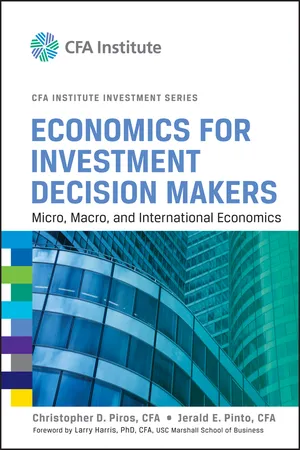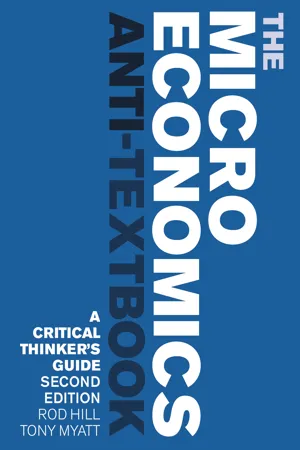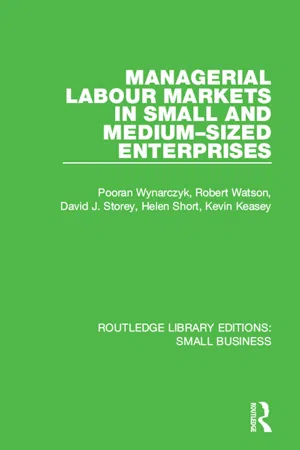Economics
Market Structures
Market structures refer to the characteristics and organization of a market, including the number of firms, the nature of competition, and the degree of market power. The main types of market structures are perfect competition, monopolistic competition, oligopoly, and monopoly. Each structure has distinct features that influence pricing, production, and market behavior.
Written by Perlego with AI-assistance
Related key terms
10 Key excerpts on "Market Structures"
- eBook - ePub
Economics for Investment Decision Makers
Micro, Macro, and International Economics
- Christopher D. Piros, Jerald E. Pinto(Authors)
- 2013(Publication Date)
- Wiley(Publisher)
2. ANALYSIS OF Market Structures
Traditionally, economists classify a market into one of four structures: perfect competition, monopolistic competition, oligopoly, and monopoly. Section 2.1 explains that four-way classification in more detail. Section 2.2 completes the introduction by providing and explaining the major points to evaluate in determining the structure to which a market belongs.2.1. Economists’ Four Types of Structure
Economists define a market as a group of buyers and sellers that are aware of each other and are able to agree on a price for the exchange of goods and services. Although the Internet has extended a number of markets worldwide, certain markets are limited by geographic boundaries. For example, the Internet search engine Google operates in a worldwide market. In contrast, the market for premixed cement is limited to the area within which a truck can deliver the mushy mix from the plant to a construction site before the compound becomes useless. Thomas L. Friedman’s international best seller The World Is Flat 1 challenges the concept of the geographic limitations of the market. If the service being provided by the seller can be digitized, its market expands worldwide. For example, a technician can scan your injury in a clinic in Switzerland. That radiographic image can be digitized and sent to a radiologist in India to be read. As a customer (i.e., patient), you may never know that part of the medical service provided to you was the result of a worldwide market.Some markets are highly concentrated, with the majority of total sales coming from a small number of firms. For example, in the market for small consumer batteries, three firms controlled 87 percent of the U.S. market as of 2005 (Duracell 43 percent, Energizer 33 percent, and Rayovac 11 percent). Other markets are very fragmented, such as automobile repairs, where small independent shops often dominate and large chains may or may not exist. New products can lead to market concentration: It is estimated that the Apple iPod had a world market share of over 70 percent among MP3 players in 2009. - eBook - ePub
Introduction to Air Transport Economics
From Theory to Applications
- Bijan Vasigh(Author)
- 2017(Publication Date)
- Routledge(Publisher)
8 Market Structure-Competitive and Monopolistic MarketsMy grandfather once told me that there are two kinds of people: those who work and those who take the credit. He told me to try to be in the first group; there was less competition there. Indira GndhiChapters 8 and 9 deal with market structure. Market structure refers to the competitive environment that surrounds the firm. it generally can be described in terms such as barriers to entry, numbers of buyers and sellers competing in the market, the individual seller’s control over price, extent of product substitutability, and the degree of mutual interdependence between firms. Market structure determines the type of competition that is found in the industry. The topics covered in this chapter are as follows:- Perfect competition, including:
- − Conditions of perfect competition
- − Perfect competition in the short run
- − Perfect competition in the long run
- Monopoly, including:
- − Legal and government barriers
- − Capital requirements
- − Technology
- − Natural barriers
- − Labor unions
- − Airports
- Price/output decision for monopolies
- Monopoly pricing and consumer well-being
- Market structure in the aviation industry
- − Aircraft manufacturing
- − Jet engine manufacturing.
Table 8.1 depicts the market continuum, and displays the four principal Market Structures. Perfect competition occurs when there are many buyers and sellers who have very little or no control over price. At the other extreme of the continuum are monopolies. Here, the market contains only one seller who has almost complete control over the output or price. These two Market Structures are the focus of this chapter. Monopolistic competition and oligopolies, otherwise known as hybrid Market Structures, are the focus of chapter 9 .Table 8.1 Market continuumPerfect Competition
A perfectly competitive industry is one in which there are a large number of small buyers and sellers who can enter and exit the industry with no restrictions. This creates a situation in which the individual firm has little or no power over the price of their good. The price is dictated by the market, and this makes the individual firms price-takers. on this basis, each firm has a simple decision: to sell at the market-bearing rate or not to sell at all. - eBook - ePub
Economic Principles and Problems
A Pluralist Introduction
- Geoffrey Schneider(Author)
- 2021(Publication Date)
- Routledge(Publisher)
Subsequently, we compare the four Market Structures, looking at the similarities and differences with respect to eight key characteristics: Barriers to entry, control over prices, the number of sellers, the typical size of firms, product differentiation, the existence of long-run above-normal profit, prices in the industry relative to lowest possible average total cost in long run (the degree of markup that firms can impose), and long-term strategic focus. We then look at how concentrated various manufacturing and service industries are by studying the extent to which certain industries are dominated by the four largest and eight largest firms.12.0 Chapter 12 learning goals After reading this chapter you should be able to:- List the key characteristics of each of the four Market Structures—perfect competition, monopolistic competition, oligopoly, and monopoly—and describe how those key characteristics explain the dynamics of each market structure.
- Define above-normal (economic) profit, normal profit, and economic loss and explain the relevance of these terms in explaining industry behavior.
- Compare and contrast the four different Market Structures using the eight key market characteristics described in this chapter.
- Identify the most likely market structure for a particular industry based on its characteristics.
- Analyze the impact of competition and concentration on industries and consumers.
12.1 Perfect competition
Economists have identified four major Market Structures in capitalist economic systems, ranging from the most competitive to the least competitive: (1) perfect competition, (2) monopolistic competition, (3) oligopoly, and (4) monopoly. The main characteristics of these Market Structures are laid out below.The main differences between these markets exist because of varying degrees of barriers to entry. Barriers to entry are factors that make it difficult for a new firm to enter an industry or market. The major sources of barriers to entry are the existence of economies of scale that require firms to be large to be competitive, control over key resources, brand name identity, and legal restrictions (patents, copyrights, trade restrictions, and government regulations). Industries with few barriers to entry tend to be very competitive because it is easy for new firms to enter the market. The high degree of competition keeps prices low and limits the market power of any one firm. Industries with significant barriers to entry have little competition, and the huge firms that dominate such industries have immense market power. - eBook - ePub
Microeconomic Principles and Problems
A Pluralist Introduction
- Geoffrey Schneider(Author)
- 2024(Publication Date)
- Routledge(Publisher)
PART IV Market Structures and corporations DOI: 10.4324/9781003368441-15 Now that we have described how markets work along with the supply and demand model, the next step in understanding markets is to analyze the different Market Structures that we find in capitalist economies. Chapter 12 introduces the four main types of Market Structures—perfect competition, monopolistic competition, oligopoly, and monopoly. Each market structure has its own dynamics and characteristics, with different kinds of competition, barriers to entry, and product differentiation. Once we can identify which market structure a particular industry fits into, that helps us to anticipate the dynamics of that industry and how firms in it will behave in response to various factors. Chapter 13 on firm costs of production develops the mainstream microeconomic model of short-run and long-run costs. We can use the laws of specialization and diminishing returns, highlighted earlier, to derive U-shaped average cost curves in the short run and long run. The shape of long-run cost curves is driven by economies and diseconomies of scale that determine the number and size of competitors. The chapter concludes with an alternative perspective on the nature of firm costs based on political economy theories. Chapter 14 develops the mainstream model of profit maximization in perfectly competitive industries. This is the perfect Smithian market structure that needs little or no regulation due to the degree of competition. The chapter lays out the assumptions behind the model, short-run profit maximization, and long-run profit maximization. The long-term model of perfect competition, where entry and exit causes firms to produce at the minimum average total cost, is discussed in relation to Adam Smith’s ideas on capitalism - eBook - ePub
Industrial Organization
Competition, Growth and Structural Change
- Kenneth George, Caroline Joll, E L Lynk(Authors)
- 2005(Publication Date)
- Routledge(Publisher)
The final section of this chapter will discuss other dimensions of structure, some of which have recently become the subject of more theoretical interest. These are: barriers to entry; vertical integration; diversification; product differentiation; growth and elasticity of demand; buyer concentration; and foreign competition. Barriers to entry, which are a very significant element of market structure in that they are the main determinant of potential competition, i.e. of the extent to which the existing firms in a market are subject to the threat of new entry, are dealt with in greater detail in .Before moving on to discuss seller concentration, we briefly consider what is meant by ‘market structure’ and its significance. The importance attached to market structure stems from the hypothesis, founded on neoclassical economic theory, that the prices, outputs, costs and profits which result in a specific market (‘market performance’) depend on the decisions taken by the firms in that market (‘market conduct’) and that, in turn, these decisions reflect the amount of autonomy firms have in terms of the competitive environment in which they make decisions. This environment is what is called ‘market structure’ and this hypothesis is called the ‘structure-conduct-performance paradigm’. At its simplest, this paradigm identifies structure as those elements over which the firm has little control, i.e. which provide constraints on its decisions, and suggests that structural factors are the most important determinants of industrial performance because the causal links run from structure to conduct to performance. Hence any attempt to understand the performance of industries should start by analysing their structure.Undoubtedly the structure-conduct-performance paradigm has provided much insight into industrial economics, but it is unwise to take the simplest version too literally. Industrial economists have always recognised, for instance, that two oligopolistic markets might share a number of structural features but end up with very different price-cost margins because the firms in those industries chose to behave differently in terms of colluding or competing. More generally, the structure of individual industries is not fixed and exogenous but changing, and some of the factors which influence structure are aspects of the conduct and performance of the firms in the industry. For instance, firms may seek to create barriers to entry by engaging in advertising, or drive other firms out of the market by predatory pricing. Hence the direction of the causal links between market structure, conduct and performance is more complex than the simplest version of the paradigm would suggest. However, recognising that it is more fruitful to treat market structure as endogenous does not mean that structural features are unimportant in explaining industrial performance, and we now turn to examining the most widely studied dimension of market structure. - eBook - ePub
The Microeconomics Anti-Textbook
A Critical Thinker's Guide - second edition
- Rod Hill, Tony Myatt(Authors)
- 2021(Publication Date)
- Zed Books(Publisher)
Chapter 6 Market structure and efficiency – or why perfect competition isn’t so perfect after all‘Perfect competition never did exist and never could exist because, even when firms are small, they do not just take the price as given but strive to make the price. All the current textbooks say as much but then they immediately go on to say that the cloud-cuckoo-land of perfect competition is the benchmark against which economists may say something significant about real-world competition …’ Mark Blaug1The point of this section of the standard textbook is to show how firm behaviour and overall efficiency depend on market structure. The exercise supposedly demonstrates that perfect competition represents an ideal market structure, while all other scenarios involve a loss of efficiency. If this were true, it could provide a compelling reason for the emphasis on the competitive market in the standard textbook. But if this isn’t the case, the emphasis on perfect competition is misplaced.1 The standard text1.1 Types of market structureAs introduced briefly in Table 3.1 , markets are classified according to the number of buyers and sellers and the nature of the goods and services being exchanged. Also important is how easy it is for firms to enter or to leave the market. In this chapter, we will describe and analyze each of these ‘Market Structures’. In all cases, there are many buyers in the market, enough that no individual buyer has any bargaining power over the price. As well, buyers and sellers are assumed to have perfect, costless information about things such as prices and product quality.1.2 Perfect competitionWe have already seen a perfectly competitive market in Chapter 3 - Peter Davis, Eliana Garcés(Authors)
- 2009(Publication Date)
- Princeton University Press(Publisher)
15.1.1 Theoretical Predictions about the Effect of Structure on Prices
Many economic models of competition can be embedded into this general two-stage structure and each will predict a relationship between market structure and market prices. We will establish the result for three important cases, namely the models in which firms are (1) price-takers, (2) oligopolists competing in prices, and (3) oligopolists competing in quantities. By examining these three canonical cases we are able to examine the mechanisms by which market structure can affect equilibrium prices. For example, we will see that, generally, a merger between two firms producing substitutes will tend to result in higher prices. Such results form the theoretical backbone of the investigations of the unilateral and multilateral effects of mergers.5.1.1.1 Market Structure among Price-Taking Firms
The structure of market supply can be important for economic efficiency in a price-taking environment since where production takes place will usually matter for the aggregate costs incurred to produce any given level of output. That is, the number of firms that are producing will usually have an effect on the total costs of production. That in turn matters because the pricing pressures that firms face are determined by the intersection of market demand and market supply, which in a price-taking environment is determined by the industry’s marginal costs of production. A reduction in the number of firms will, except in special circumstances, reduce the aggregate supply to the market and hence induce the price to rise. Higher prices in turn induce increases in supply from at least one remaining active firm that, if it suffers from diseconomies of scale, will nonetheless find it profitable to produce extra output despite higher unit costs. Because of the potential diseconomies of scale, a lower number of firms may result in higher prices required to sustain a given level of aggregate output. Generally therefore, assuming a price-sensitive demand and firm-level diseconomies of scale, an equilibrium involving a reduced set of firms will involve lower quantities and higher prices.- David Reisman(Author)
- 2013(Publication Date)
- Routledge(Publisher)
2 and that there is more merit in being fuzzily right than in being precisely wrong. In his ambiguous and open-ended way he seems to have treated all four of the principal Market Structures that figure in contemporary economics textbooks, and it is with these four Market Structures that we shall be concerned in the four sections of the present chapter.6.1 PERFECT COMPETITION
The theoretical analysis of perfect competition, Stigler says, was long treated ‘with the kindly casualness with which one treats of the intuitively obvious’: ‘It is a remarkable fact that the concept of competition did not begin to receive explicit and systematic attention in the main stream of economics until 1871.’1 Economics rapidly made up for lost time and extensive definitions may be found in books such as Jevons' Theory of Political Economy (1871) and Edgeworth's Mathematical Psychics (1881).2 Marshall's own definition is as follows: ‘A perfect market is a district, small or large, in which there are many buyers and many sellers all so keenly on the alert and so well acquainted with one another's affairs that the price of a commodity is always practically the same for the whole of the district.’3 In such a market, ‘buyers generally compete freely with buyers, and sellers compete freely with sellers’,4 and the outcome of such ‘free competition’ is precisely what we would anticipate: there is ‘only one price on the market at one and the same time’ and no dealer is driven to ‘taking a lower or paying a higher price than others are doing’.5 Always assuming, of course, that four conditions implicit in the definition of the perfect market are satisfied.First , product homogeneity. We must assume that ‘the commodities referred to are always of the same quality’.6 This is the case, for example, with ‘raw produce’ (including the ubiquitous fresh fish), and also with some manufactured outputs - as where the goods in question are ‘so simple and uniform’, so ‘plain and common’, that their production ‘can be reduced to routine’ and their distribution can be ‘wholesale in vast quantities’ (goods like, say, ‘steel rails and calico’ which are available at a multiplicity of different outlets).7 Homogeneity in the sense of the economist must not, however, be confused with homogeneity in the sense of the physicist, as Marshall reflected in an important footnote on the subjective and the objective which occurs in his fragmentary Essay on Value and which reads as follows: ‘Inequalities of price are indeed often more apparent than real. A man who pays four shillings for a pair of gloves which he knows he could have bought in the next street for three, pays three shillings for the gloves and expends the fourth on love of display, on indulgence of old associations, or saving of time. He buys something extra just as much as if the gloves had had extra fancy work upon them.’8- Pooran Wynarczyk, Robert Watson, David J. Storey, Helen Short, Kevin Keasey(Authors)
- 2016(Publication Date)
- Routledge(Publisher)
3 Non-economic explanations of firm structure, management and performanceINTRODUCTIONChapter 2 reviewed a number of economic explanations of the relationships between the internal organization of firms, their market environments and their performance. These explanations emphasized the importance of various forms of ‘cost minimizing’ imperatives by self-interested agents in the context of either perfect or imperfect markets. Perfect markets are characterized by many buyers and sellers of a homogeneous product, none of whom by their own actions are able to influence price. Information is freely available in the market and there are no restrictions on entry or exit. Entry takes place in response to market opportunities, defined as a situation where price persistently exceeds long run average cost.On the other hand, in imperfect markets there is uncertainty, barriers to entry, specific (quasi-rent receiving) asset investments and information asymmetries. Such market features create transactional difficulties for market participants. However, they are also the source of new profit opportunities, and of innovation and change in the economy as a whole.Specific market environments are seen to determine the particular type(s) of internal organization that minimize the (costly) problems associated with the drawing-up of complete, state-contingent, contracts between opportunistic agents. Contemporary economic explanations suggest, therefore, that for any particular configuration of market imperfections, there will also be a cost-minimizing internal contracting and monitoring system. But, assuming incentive and monitoring problems can be overcome, successful firms will tend to adopt forms of ownership rights and internal organization that enhance the firm’s value and its probability of survival.- eBook - ePub
Management Economics: An Accelerated Approach
An Accelerated Approach
- William G. Forgang, Karl W. Einolf(Authors)
- 2015(Publication Date)
- Routledge(Publisher)
In the long run, the perfectly competitive firm produces where marginal revenue equals marginal cost and price equals average cost. The firm makes zero economic profit, but it does make an accounting profit. However, the firm does no better than its next best alternative in another market. Another notable result is that the firm is producing at the lowest point on its average cost curve. The firm has no excess capacity, and its resources are allocated efficiently. Perfect competition provides the best situation for society, as consumers pay the lowest possible price and firms do not waste resources in inefficient markets.Managers of perfectly competitive firms focus on managing their businesses as cost-effectively as possible. Because competition is so intense in a perfectly competitive market, only firms that produce at the lowest possible cost survive. If more efficient firms outside the market see profit potential, they enter and drive inefficient firms out of business.Exercise 6.8Describe a product that is sold in a perfectly competitive market. Describe the conditions in this market with respect to distinctiveness of competitors’ products, number of competitors, control over price, conditions of entry, and level of advertising.SummaryThis chapter described the microeconomic environments in which firms operate. The process by which managers make decisions—including how to determine price, calculate production needs, and implement a marketing plan—depends heavily on the microeconomic structure of the industry. Each of the four Market Structures—monopoly, oligopoly, monopolistic competition, and perfect competition—were described to help managers understand how dependent they are on these economic environments. To maximize profit, increase market share, and effectively compete, managers must understand their firm’s strategic position in its industry.
Index pages curate the most relevant extracts from our library of academic textbooks. They’ve been created using an in-house natural language model (NLM), each adding context and meaning to key research topics.









